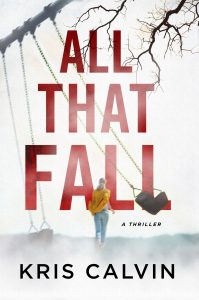Gayle Lynds: Step into the wickedly talented world of debut author Kris Calvin. In a case to die for, Kris’s first novel, ALL THAT FALL, follows Emma Lawson, the youngest lead government ethics investigator in California’s state capital. Kris herself was CEO of the American Academy of Pediatrics for more than 20 years and knows whereof she writes. I’ll be chatting with her at 8:00 PM EDT Friday, April 23, in a virtual event at the legendary Murder by the Book. For details, click here. Please join us!
These days, thriller novels come in a variety of subgenres, from classic espionage and political thrillers to suspense, psychological and thriller/mysteries. At their best, they share the ability to make the reader’s heart pound, and to engage them in an emotional and visceral way. To that end, most thriller authors welcome a review that states their story has “nonstop action.”

But is it possible for a thriller to move too fast?
I think it is, and when it does, the reader doesn’t always identify the fault as being with the pacing. When a reader describes characters in an action-heavy thriller as shallow, complains there are too many points of view, or asserts the plot is confusing, it may be that runaway pacing has left them unable to appreciate the real strengths of the story.
Whether you are spinning a dazzling tale of espionage or devising a nail-biting psychological drama, the four tips below are intended to help you achieve thriller pacing that allows all elements of your work in progress to shine, leaving your readers truly thrilled!
Belay
I’m not a rock climber. (I should ask thriller author Chris Goff about this!) But one expert states, “Belaying is relatively simple, provided one is paying attention to your climbing partner…always have at least one hand on the brake end of the rope…This limits the distance the climber can fall.” (Rick Curtis, Outdoor Action Guide to Belaying.)
For a thriller writer, your “rope” is the throughline of your story. There will be subplots, of course, but your reader must connect everything that happens, from beginning to end, to the overarching goal of your narrative. If you write in first person, the problem may be solved if your reader is anchored by the voice that occurs throughout.
But what about those of us who employ multiple POVs? What is to stop the reader from putting the book down if, despite the rollicking action, they lose interest in the book’s final outcome? Frequently, (however you define that, I use every other chapter) ask yourself what you’ve provided in recent scenes that ties current action to the ultimate goal. It may be something small like a single phrase, a character’s name, or a reference to a setting. Don’t rely on your reader to hang on by themselves—the faster and more intense the action, the more important it is that you don’t let them “fall”!

Talk to me, baby
Fight scenes, car chases, or a growing sense of foreboding achieved through a darkening sky and sweat trickling down a character’s neck can all engage your reader emotionally, through physical movement and changes in setting. As humans, we are also affected by what people say to us, to one another, and to themselves (if we’re given a window into their thoughts).
The right dialogue complements action to make characters come alive. More than that, dialogue engages a different part of your reader’s brain, and adds depth to how they experience your story. Pacing should take this into account.
After completing the first draft of a thriller, I create a spreadsheet tracking the number of scenes in which each of my significant characters appears, and in what proportion of those scenes they have a speaking or “thinking” role. This may seem, at first, to go against the “show don’t tell” instruction we all take to heart. But you’re not telling the reader what characters think or want. Dialogue, when skillfully applied, is an action, it’s part of the “show.”
Ticktock
A ticking clock can be literal. 12 minutes to diffuse the bomb! Or not. As Deb’s ex-husband’s unrelenting obsession grew, her sanity unraveled, and she didn’t think she could take it much longer.
Either way, it represents an implicit contract with the reader. You’re telling them, in effect, “Stay with my protagonist in whatever they might face, and you WILL get to see the end of it.” If your thriller does not incorporate an actual time limit, find another way to assure your reader things are not open-ended, that this can’t go on forever.
Time to ponder
Reading is not a spectator sport. Unlike a movie, which puts the viewer in a passive position with pacing predetermined by directors (and producers), a reader has a measure of control. An author supports the reader’s active role in pacing by providing them “space to ponder”.
Some writers do this organically, without thinking about it, at the end of some or all of their chapters. For example, if Chapter 3 closes with, “Therese couldn’t bear to consider what might happen to Sean if she did not get there in time,” the reader may pause as they picture Therese’s distress, allowing themselves to feel the magnitude of what she feels, before turning the page to Chapter 4.
These breakpoints can be especially important in thrillers that feature extreme or ongoing violence as a necessary part of the story. When your reader is able to choose at various moments whether to pause and reflect or to barrel on through, you widen your potential audience, and provide a fuller emotional experience.
Which, when all is said and done, is what storytelling, including thrillers, is all about.
Dear Rogue Readers … How do you like the books you read to be paced … blood-curdling fast, snooze slow, or perhaps somewhere in between? Educate us!
















































What terrific tips, Kris. I was particularly taken by your “Talk to me, baby” section about the importance of dialog as its being action itself, as well as important in helping the rhythm and velocity of a scene. Narration has often been held up as the epitome of great writing, but I so disagree. Dialog — great dialog like yours — is critical. See you at our Murder by the Book conversation next Friday, April 23. Loved All THAT FALL!
All of Kris’s comments and suggestions about pacing are so right-on, so cogent and helpful that it’s hard to imagine ALL THAT FALL is her very FIRST novel. (She writes like a true veteran of the genre). In fact, when “Thrillerfest,” the annual conference of our International Thriller Writers organization (founded, by the way, by our own Gayle Lynds) gets under way in person in 2022 (I hope) — it would be great to have Kris leading a session on pacing. Let’s keep that in mind. Meanwhile, can’t wait to read ALL THAT FALL – and thanks, Kris, for joining us here on our Rogue website!
Your hints are coming just at the right time for me. I just started a new book, so now I know where to remind myself to keep a focus!
I love the idea of examining where your metaphoric if not literal “ticktock” lies in a story! I have a post by Kristen Lamb up on the role of change in a story–I think this ties into Kris’ excellent exploration of pacing. When new elements, either material or psychological, don’t keep coming in a story, I tend to find it flat.
This is some of the best advice I’ve heard for writing a thriller. Love the analogy of BELAY. That sticks with me, and I will definitely be considering all four points while I’m working on my newest novel. Thanks!